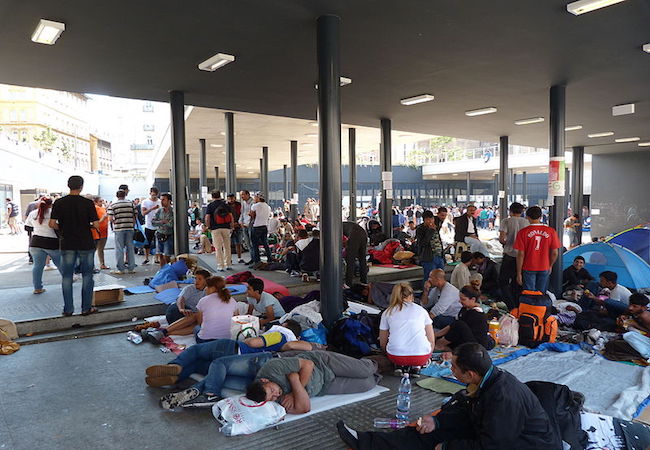
By Banu Arslan
On their way to Europe, Syrian migrants carry to the west an increasing number of problems. One of these problems can be seen in the child marriages that we in Turkey are already familiar with because of the existing issue of “child brides”.
The Universal Declaration of Human Rights states that “marriage shall be entered into only with the free and full consent of the intending spouses” (Article 16.2). Although a specific age of consent, which is one of the conditions of a free marriage, is not specified by the Declaration, international conventions set the minimum age for consensual marriage at 18. For instance, the United Nations Convention on the Rights of the Child defines the child as “a person below the age of 18 unless the laws of a particular country set the legal age for adulthood younger” (Article 1). In this sense, marriages including spouses under the age of 18 can be regarded as child marriages, which are outlawed by international law such as that outlined in the Convention on the Elimination of All Forms of Discrimination Against Women (CEDAW, Article 16).
Child marriage is condemned by human/women rights advocates on many grounds. First of all, seeing that children are below the age of consent, their entry into a marriage becomes a means for sexual violence and is therefore regarded as a violation of human rights. In addition to their devastating psychological effects on children, child marriages can inflict physical harm as well. Seeing that children are not physically mature enough to bear a child, they are more likely to lose their lives during pregnancy and childbirth. Besides, although parents usually intend to improve the living conditions of their children when allowing them to enter into early marriages, this process usually evinces reversed results as the living conditions of the child worsen often as a result of increased vulnerability to domestic violence.
Although many measures have been taken to prevent child marriages, it is still practiced in many parts of the world.
Child Marriage (%) 2002 - 2011*
| Married by 15 | Married by 18 | |
|---|---|---|
| Sub-Saharan Africa | 12 | 37 |
| Eastern and Southern Africa | 9 | 34 |
| West and Central Africa | 14 | 41 |
| Middle East and North Africa | 3 | 17 |
| South Asia | 18 | 46 |
| East Asia and Pacific ** | 3 | 18 |
| Latin America and Caribbean | 7 | 29 |
| CEE/CIS | 1 | 10 |
| Least Developed Countries | 16 | 46 |
| World ** | 11 | 34 |
**excluding China (Source: The State of the World’s Children 2013 Report)
According to the data set above, the rate of child marriage is the highest in South Asia followed by West and Central Africa, whereas it is the lowest in Central and Eastern Europe. The same data set indicates that least developed countries have a 12% higher rate of child marriage than the world average. Although the quantitative data points to a positive relationship between the prevalence of child marriage and the country’s economic profile, the issue cannot be solely reduced to economic factors seeing that the phenomenon also has deep rooted social, cultural and political dimensions as well.
Although the issue is generally conceptualized as “child” marriage, specifically, it is usually the female child who is under the age of consent and forced to marry an elder man, especially within the context of Syrian refugee communities. This reality therefore raises the issue of “child brides”. Here, the problem is dovetailed with the Syrian Civil War and the mass migration therefrom. According to the UNHCR, since 2011, the total number of Syrian refugees fleeing their country has exceeded 4 million, more than half of which are women and children.
There is an overall consensus that women and children are the most vulnerable groups affected by war, and in this sense, among the Syrian refugee communities child marriages have become an increasingly dangerous trap for Syrian girls. One of the reasons why Syrian girls are forced into child marriages stems from the security concerns of their families, as marriage is often regarded as a way for the girl to escape war and poor living conditions.
Another reason for child marriage in warzones is to protect young girls from sexual assault. In the case that the girl is exposed to sexual assault, this will not only not only degrade the girl but at the same time the whole family as a result of traditional notions of honor. In this way it is assumed by families that their girls may be saved from sexual assault by the way of marriage. Here, it should also be added that child marriage is culturally acceptable in large segments of the Syrian society, where it had existed as a custom even before the war began.
UN reports have been pointing to an increase in the number of child marriages among Syrian refugee communities in Syria’s neighboring countries. But what is new in this context is that Western societies, which have so far seemed to be isolated from these societal problems, will now have to face these issues together with the increasing number of Syrian child brides entering their territories. Such a dynamic might force them to make changes to their family laws.
When the West meets the child bride
This issue recently became a hot topic in the media when a nine-month pregnant 14 year old girl who may have been in need of medical care disappeared from a Dutch asylum center. Dutch asylum law allows child brides to be reunited with their husbands living in the Netherlands, and there have been cases in which young girls between the ages of 13 and 15 have been allowed to join their husbands at asylum centers in the Netherlands. As Dutch Minister for Immigration Klaas Dijkhoff told the BBC, the Netherlands recognizes marriages that involve teenagers in the case that these marriages are legally acceptable in their country of origin.
As a result of the Dutch case, discussions on amending the family laws of various European countries have increased, with many calling for more preventive measures with respect to child marriages. In this regard, it would not be a surprise to see the enactment of stricter family laws in Europe that neither allow nor recognize marriages in which one party is below the age of 18.
However, although preventive laws are very important in combating child marriage, legal arrangements are not enough to cope with the issue in refugee and host communities. Such an endeavor should go hand in hand with measures to protect girls from child marriage. In this sense, policies should be developed to empower and arm girls with tools that will allow them to stand on their own two feet and integrate into the host society.
Now that Europe will come to face this challenge at home, it is time for it to prove its commitment to women’s rights.
Banu Arslan is a researcher at the Center for Social Studies of the International Srategic Research Organization (USAK). She is also a PhD candidate in Political Science at the Bilkent University. Her meain research intrests include the role of the media in politics, state society relations in Turkey, governance in domestic politics, Turkish politics and gender studies.




